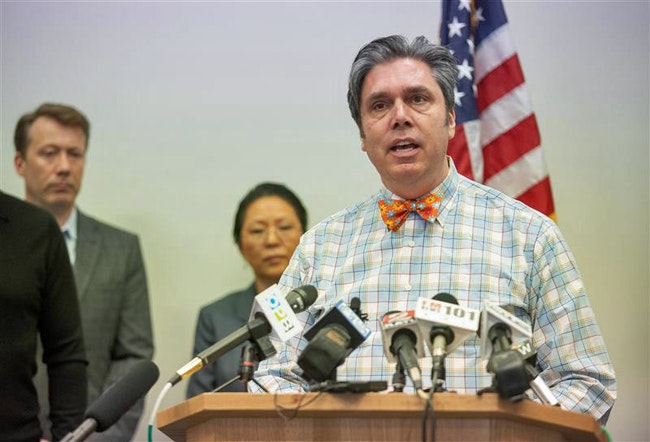
Dr. Dean Sidelinger, the Oregon state health officer, announces new state restrictions in a news conference in Portland on Thursday, March 12. (Jonathan House/Pamplin Media)
NOTE: The Enterprise is providing free access to its content related to the coronavirus as a community service. Subscriptions help support this.
SALEM – In a matter of hours, the need to close Oregon schools came into sharp focus for Gov. Kate Brown.
Schools, she was told, expected to quickly run short of staff as concerns deepened over the novel coronavirus.
In the night hours of Thursday, March 12, Brown pushed out the word – every public school in Oregon would close on Monday, March 16.
Across Oregon, school districts are scrambling to put together entirely new systems for packaging and delivering meals to all students. State officials are considering adding flexibility for licensed child care facilities, aware that parents are faced with choices about what to do with their children.
None of that was because children were becoming infected, Brown told reporters Friday. Public health officials say that so far children generally seem to suffer mild symptoms that can be cared for at home if they do contract COVID-19.
Colt Gill, state deputy superintendent of public instruction, said state and federal health officials made clear to Oregon authorities that “sending children home will not stop the spread of coronavirus.”
Instead, school employees considered vulnerable to the disease, particularly those 60 and over, were rapidly deciding to stay away from schools.
That ranged from substitute teachers to bus drivers to cafeteria workers who tend to about 580,000 children in Oregon’s public schools.
Through much of last week, Brown resisted any move to shutter schools.
On Sunday, March 8, Brown declared a state of emergency when the number of people testing positive for the disease doubled overnight to 14. State agencies issued guidance that then recommended against closing schools but urged increased hand washing and cleaning of schools and “social distancing” by staggering recesses and lunch periods.
Three days later, Brown issued new orders aimed at containing the virus. This time, schools were directed to cancel field trips, parent conferences and competitions.
That day, Brown said, she held a conference call with school superintendents. She said she heard a “universal commitment” to keep schools open, in part because of the deep effect closing them would have on vulnerable families.
“A lot of these kids don’t necessarily have direct access” to meals, health care and other services they get at school, Brown said.
She went before reporters the following morning, restating that stand and assuring Oregonians that everything was being done to safeguard schools.
“Considerations of school closures would be a last resort,” she told Oregon.
A series of subsequent calls with school superintendents and others culminated in a conference call just hours later – at 4 p.m. Thursday, March 12 – that convinced her she could no longer leave schools open. Other states already were beginning to order statewide closures and Oregon school districts were considering acting on their own to turn off the classroom lights.
School superintendents, union officials and state education authorities were on the call with the governor, who was working from Portland. Her chief of staff, Nik Blosser, and her policy advisers on education and health joined in.
One message came through, Brown said: “They are struggling to even staff their schools at this point” in a circumstance pushing school systems to “the breaking point.”
She said 40% of Oregon’s substitute teachers are 60 or older – a population that shouldn’t be in contact with kids. She said school districts also rely heavily on that demographic for bus drivers and the “lunchroom ladies.”
The Oregon Education Association, representing many of the state’s teachers, added its voice to push for the closure as it learned that more and more school employees were voicing reluctance to work at school.
In the coming hours, Brown and her team put together the order to force closures in 127 school districts, and the announcement went just after 10 p.m. Thursday.
“This means now that every single one of our children is experiencing the crisis up close and personal,” Brown said.
She recounted how the child of one of her staffers the next morning cried at the news.
But the closure order raised questions and caught school officials off guard, particularly the governor’s instruction that they find a way to keep feeding kids.
By Friday night, school executives were announcing how they would do that. The latest state data showed about 275,000 school children were eligible for free or discounted meals. In schools with high poverty rates, rules trigger provisions that mean every student ate for free. Now, based on school district announcements, school food servers were preparing to feed any student who wanted a meal.
As the food issue unfolds, state and local education officials are confronted with other challenges.
Pay for school employees is a key one, with local union contracts largely governing whether employees off duty because of the governor’s order would get paid. That means there are variations from district to district. The teachers union is pressing state officials to adopt a uniform policy for every school employee, ensuring no one goes without pay.
And then there is the question of the school year and loss of instructional time. Gill, in charge of the state Education Department, said that the coming week’s closure could be made up with other days schools planned to be closed or by extending the school year.
He noted, however, that such plans might change if schools have to remain closed longer than planned. Students are now expected to be back in class by April 1.
Gill said state authorities sometime during the week of spring break would decide whether to stick with that schedule – or extend the closure.
“Right now,” Gill said, “we need to focus on the needs of our children, our families and our communities.”
Les Zaitz is editor of the Malheur Enterprise. Contact: [email protected].




